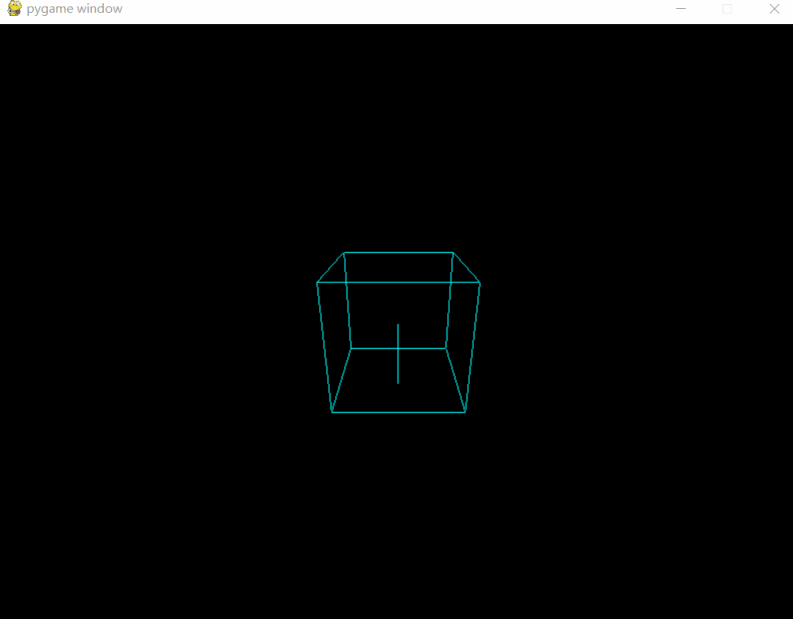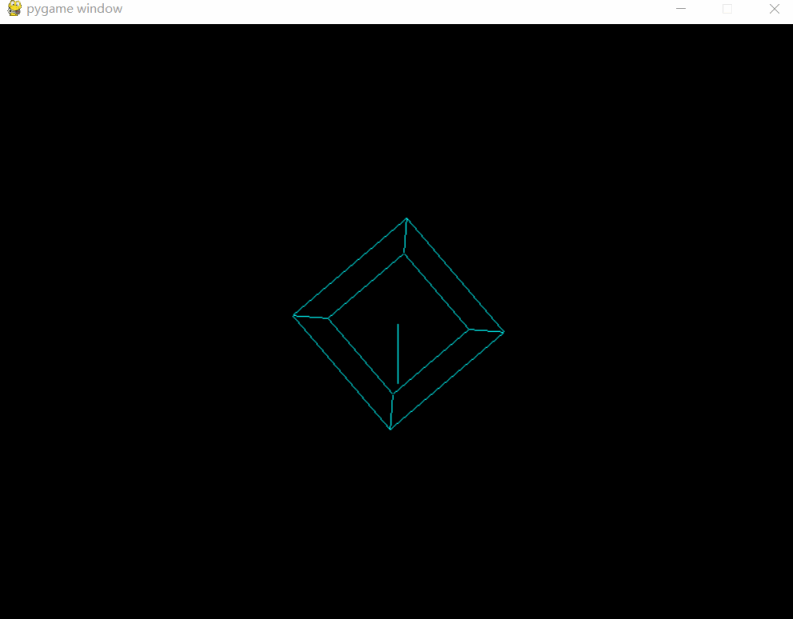整体旋转
代码
### import pygame
from pygame.locals import *
from OpenGL.GL import *
from OpenGL.GLU import *
verticies = (
(1, ### -1, -1),
(1, 1, -1),
(-1, 1, -1),
(-1, -1, -1),
(1, ### -1, 1),
(1, 1, 1),
(-1, -1, 1),
(-1, 1, 1)
)
edges = (
(0,1),
(0,3),
(0,4),
(2,1),
(2,3),
(2,7),
(6,3),
(6,4),
(6,7),
(5,1),
(5,4),
(5,7)
)
def Cube():
glColor3f(0.0, 1.0, 1.0)
glPolygonMode(GL_FRONT, GL_FILL)
glPolygonMode(GL_BACK, GL_FILL)
# 设置两面均为顶点绘制方式
glBegin(GL_LINES) #glBegin和glEnd()是绘图的必备函数
for edge in edges:
for vertex in edge:
glVertex3fv(verticies[vertex]) #这个函数就是连点,这个函数执行两次画一条线,两点确定一条直线,参数为三维的坐标
glVertex3f(0,-1,0) #这个函数执行两次画一条线
glVertex3f(0,0,-1)
glEnd()
def main():
pygame.init() #pygame的一些初始化不用管
display = (800,600)
pygame.display.set_mode(display, DOUBLEBUF|OPENGL)
gluPerspective(450,(display[0]/display[1]), 0.5, 50.0)
#参数1是我们看显示物体的远近
#参数2是物体显示的长宽比,和窗口长宽比相同就行
#参数3和4是z轴近和远的裁剪面的距离,但是还是不太明白要这干啥
glTranslatef(0.0,0.0, -5) #Z轴就是我们眼睛到屏幕方向的轴,负是远,正是近,其实就是让物体相对与屏幕在XYZ各方向移动几个距离
while True:
for event in pygame.event.get():
if event.type == pygame.QUIT: #退出事件响应
pygame.quit()
quit()
glRotatef(1, 1, 1, 1)
#参数1是旋转的速度,
#参数2是x, y and z的一个坐标,表示从(0,0,0)点到(x,y,z)这条线为轴进行旋转
glClear(GL_COLOR_BUFFER_BIT|GL_DEPTH_BUFFER_BIT) #用来删除就得画面,清空画布
Cube() #创建模型
pygame.display.flip() #显示画面
pygame.time.wait(10) #10ms刷新一次
main()
绕X轴旋转
代码
### import pygame
from pygame.locals import *
from OpenGL.GL import *
from OpenGL.GLU import *
import numpy as np
verticies = [
[1, -1, -1],
[1, 1, ### -1],
[-1, 1, -1],
[-1, -1, -1],
[1, -1, 1],
[1, 1, 1],
[-1, -1, 1],
[-1, 1, 1]
]
edges = (
(0, 1),
(0, 3),
(0, 4),
(2, 1),
(2, 3),
(2, 7),
(6, 3),
(6, 4),
(6, 7),
(5, 1),
(5, 4),
(5, 7)
)
def position_transformations_x(x0, y0, z0, o): # 齐次坐标变换-绕X轴旋转
P0 = np.array([[x0], [y0], [z0], [0]])
transformations = np.array(
[[1, 0, 0, 0], [0, np.cos(o), -np.sin(o), 0], [0, np.sin(o), np.cos(o), 0], [0, 0, 0, 1]])
P = np.dot(transformations, P0)
return P[0][0], P[1][0], P[2][0]
def position_transformations_y(x0, y0, z0, o): # 齐次坐标变换-绕Y轴旋转
P0 = np.array([[x0], [y0], [z0], [0]])
transformations = np.array(
[[np.cos(o), 0, np.sin(o), 0], [0, 1, 0, 0], [-np.sin(o), 0, np.cos(o), 0], [0, 0, 0, 1]])
P = np.dot(transformations, P0)
return P[0][0], P[1][0], P[2][0]
def position_transformations_z(x0, y0, z0, o): # 齐次坐标变换-绕Z轴旋转
P0 = np.array([[x0], [y0], [z0], [0]])
transformations = np.array(
[[np.cos(o), -np.sin(o), 0, 0], [np.sin(o), np.cos(o), 0, 0], [0, 0, 1, 0], [0, 0, 0, 1]])
P = np.dot(transformations, P0)
return P[0][0], P[1][0], P[2][0]
def position_trans(x0, y0, z0, dx, dy, dz): # 齐次坐标变换-进行平移变换
P0 = np.array([[x0], [y0], [z0], [0]])
transformations = np.array(
[[1, 0, 0, dx], [0, 1, 0, dy], [0, 0, 1, dz], [0, 0, 0, 1]])
P = np.dot(transformations, P0)
return P[0][0], P[1][0], P[2][0]
def Cube():
glColor3f(0.0, 1.0, 1.0)
glPolygonMode(GL_FRONT, GL_FILL)
glPolygonMode(GL_BACK, GL_FILL)
# 设置两面均为顶点绘制方式
for point in verticies:
print("point:", point)
x,y,z = point
x,y,z = position_transformations_x(x, y, z, 0.01)
point[0] = x
point[1] = y
point[2] = z
pass
glBegin(GL_LINES) # glBegin和glEnd()是绘图的必备函数
for edge in edges:
for vertex in edge:
glVertex3fv(verticies[vertex]) # 这个函数就是连点,这个函数执行两次画一条线,两点确定一条直线,参数为三维的坐标
glVertex3f(0, -1, 0) # 这个函数执行两次画一条线
glVertex3f(0, 0, -1)
glEnd()
def main():
pygame.init() # pygame的一些初始化不用管
display = (800, 600)
pygame.display.set_mode(display, DOUBLEBUF | OPENGL)
gluPerspective(450, (display[0] / display[1]), 0.5, 50.0)
# 参数1是我们看显示物体的远近
# 参数2是物体显示的长宽比,和窗口长宽比相同就行
# 参数3和4是z轴近和远的裁剪面的距离,但是还是不太明白要这干啥
glTranslatef(0.0, 0.0, -5) # Z轴就是我们眼睛到屏幕方向的轴,负是远,正是近,其实就是让物体相对与屏幕在XYZ各方向移动几个距离
while True:
for event in pygame.event.get():
if event.type == pygame.QUIT: # 退出事件响应
pygame.quit()
quit()
# glRotatef(1, 1, 1, 1)
# 参数1是旋转的速度,
# 参数2是x, y and z的一个坐标,表示从(0,0,0)点到(x,y,z)这条线为轴进行旋转
glClear(GL_COLOR_BUFFER_BIT | GL_DEPTH_BUFFER_BIT) # 用来删除就得画面,清空画布
Cube() # 创建模型
pygame.display.flip() # 显示画面
pygame.time.wait(10) # 10ms刷新一次
main()
绕Z轴旋转
代码
### import pygame
from pygame.locals import *
from OpenGL.GL import *
from OpenGL.GLU import *
import numpy as np
verticies = [
[1, -1, -1],
[1, 1, ### -1],
[-1, 1, -1],
[-1, -1, -1],
[1, -1, 1],
[1, 1, 1],
[-1, -1, 1],
[-1, 1, 1]
]
edges = (
(0, 1),
(0, 3),
(0, 4),
(2, 1),
(2, 3),
(2, 7),
(6, 3),
(6, 4),
(6, 7),
(5, 1),
(5, 4),
(5, 7)
)
def position_transformations_x(x0, y0, z0, o): # 齐次坐标变换-绕X轴旋转
P0 = np.array([[x0], [y0], [z0], [0]])
transformations = np.array(
[[1, 0, 0, 0], [0, np.cos(o), -np.sin(o), 0], [0, np.sin(o), np.cos(o), 0], [0, 0, 0, 1]])
P = np.dot(transformations, P0)
return P[0][0], P[1][0], P[2][0]
def position_transformations_y(x0, y0, z0, o): # 齐次坐标变换-绕Y轴旋转
P0 = np.array([[x0], [y0], [z0], [0]])
transformations = np.array(
[[np.cos(o), 0, np.sin(o), 0], [0, 1, 0, 0], [-np.sin(o), 0, np.cos(o), 0], [0, 0, 0, 1]])
P = np.dot(transformations, P0)
return P[0][0], P[1][0], P[2][0]
def position_transformations_z(x0, y0, z0, o): # 齐次坐标变换-绕Z轴旋转
P0 = np.array([[x0], [y0], [z0], [0]])
transformations = np.array(
[[np.cos(o), -np.sin(o), 0, 0], [np.sin(o), np.cos(o), 0, 0], [0, 0, 1, 0], [0, 0, 0, 1]])
P = np.dot(transformations, P0)
return P[0][0], P[1][0], P[2][0]
def position_trans(x0, y0, z0, dx, dy, dz): # 齐次坐标变换-进行平移变换
P0 = np.array([[x0], [y0], [z0], [0]])
transformations = np.array(
[[1, 0, 0, dx], [0, 1, 0, dy], [0, 0, 1, dz], [0, 0, 0, 1]])
P = np.dot(transformations, P0)
return P[0][0], P[1][0], P[2][0]
def Cube():
glColor3f(0.0, 1.0, 1.0)
glPolygonMode(GL_FRONT, GL_FILL)
glPolygonMode(GL_BACK, GL_FILL)
# 设置两面均为顶点绘制方式
for point in verticies:
print("point:", point)
x,y,z = point
x,y,z = position_transformations_z(x, y, z, 0.01)
point[0] = x
point[1] = y
point[2] = z
pass
glBegin(GL_LINES) # glBegin和glEnd()是绘图的必备函数
for edge in edges:
for vertex in edge:
glVertex3fv(verticies[vertex]) # 这个函数就是连点,这个函数执行两次画一条线,两点确定一条直线,参数为三维的坐标
glVertex3f(0, -1, 0) # 这个函数执行两次画一条线
glVertex3f(0, 0, -1)
glEnd()
def main():
pygame.init() # pygame的一些初始化不用管
display = (800, 600)
pygame.display.set_mode(display, DOUBLEBUF | OPENGL)
gluPerspective(450, (display[0] / display[1]), 0.5, 50.0)
# 参数1是我们看显示物体的远近
# 参数2是物体显示的长宽比,和窗口长宽比相同就行
# 参数3和4是z轴近和远的裁剪面的距离,但是还是不太明白要这干啥
glTranslatef(0.0, 0.0, -5) # Z轴就是我们眼睛到屏幕方向的轴,负是远,正是近,其实就是让物体相对与屏幕在XYZ各方向移动几个距离
while True:
for event in pygame.event.get():
if event.type == pygame.QUIT: # 退出事件响应
pygame.quit()
quit()
# glRotatef(1, 1, 1, 1)
# 参数1是旋转的速度,
# 参数2是x, y and z的一个坐标,表示从(0,0,0)点到(x,y,z)这条线为轴进行旋转
glClear(GL_COLOR_BUFFER_BIT | GL_DEPTH_BUFFER_BIT) # 用来删除就得画面,清空画布
Cube() # 创建模型
pygame.display.flip() # 显示画面
pygame.time.wait(10) # 10ms刷新一次
main()
绕Y轴旋转
代码
### import pygame
from pygame.locals import *
from OpenGL.GL import *
from OpenGL.GLU import *
import numpy as np
verticies = [
[1, -1, -1],
[1, 1, ### -1],
[-1, 1, -1],
[-1, -1, -1],
[1, -1, 1],
[1, 1, 1],
[-1, -1, 1],
[-1, 1, 1]
]
edges = (
(0, 1),
(0, 3),
(0, 4),
(2, 1),
(2, 3),
(2, 7),
(6, 3),
(6, 4),
(6, 7),
(5, 1),
(5, 4),
(5, 7)
)
def position_transformations_x(x0, y0, z0, o): # 齐次坐标变换-绕X轴旋转
P0 = np.array([[x0], [y0], [z0], [0]])
transformations = np.array(
[[1, 0, 0, 0], [0, np.cos(o), -np.sin(o), 0], [0, np.sin(o), np.cos(o), 0], [0, 0, 0, 1]])
P = np.dot(transformations, P0)
return P[0][0], P[1][0], P[2][0]
def position_transformations_y(x0, y0, z0, o): # 齐次坐标变换-绕Y轴旋转
P0 = np.array([[x0], [y0], [z0], [0]])
transformations = np.array(
[[np.cos(o), 0, np.sin(o), 0], [0, 1, 0, 0], [-np.sin(o), 0, np.cos(o), 0], [0, 0, 0, 1]])
P = np.dot(transformations, P0)
return P[0][0], P[1][0], P[2][0]
def position_transformations_z(x0, y0, z0, o): # 齐次坐标变换-绕Z轴旋转
P0 = np.array([[x0], [y0], [z0], [0]])
transformations = np.array(
[[np.cos(o), -np.sin(o), 0, 0], [np.sin(o), np.cos(o), 0, 0], [0, 0, 1, 0], [0, 0, 0, 1]])
P = np.dot(transformations, P0)
return P[0][0], P[1][0], P[2][0]
def position_trans(x0, y0, z0, dx, dy, dz): # 齐次坐标变换-进行平移变换
P0 = np.array([[x0], [y0], [z0], [0]])
transformations = np.array(
[[1, 0, 0, dx], [0, 1, 0, dy], [0, 0, 1, dz], [0, 0, 0, 1]])
P = np.dot(transformations, P0)
return P[0][0], P[1][0], P[2][0]
def Cube():
glColor3f(0.0, 1.0, 1.0)
glPolygonMode(GL_FRONT, GL_FILL)
glPolygonMode(GL_BACK, GL_FILL)
# 设置两面均为顶点绘制方式
for point in verticies:
print("point:", point)
x,y,z = point
x,y,z = position_transformations_y(x, y, z, 0.01)
point[0] = x
point[1] = y
point[2] = z
pass
glBegin(GL_LINES) # glBegin和glEnd()是绘图的必备函数
for edge in edges:
for vertex in edge:
glVertex3fv(verticies[vertex]) # 这个函数就是连点,这个函数执行两次画一条线,两点确定一条直线,参数为三维的坐标
glVertex3f(0, -1, 0) # 这个函数执行两次画一条线
glVertex3f(0, 0, -1)
glEnd()
def main():
pygame.init() # pygame的一些初始化不用管
display = (800, 600)
pygame.display.set_mode(display, DOUBLEBUF | OPENGL)
gluPerspective(450, (display[0] / display[1]), 0.5, 50.0)
# 参数1是我们看显示物体的远近
# 参数2是物体显示的长宽比,和窗口长宽比相同就行
# 参数3和4是z轴近和远的裁剪面的距离,但是还是不太明白要这干啥
glTranslatef(0.0, 0.0, -5) # Z轴就是我们眼睛到屏幕方向的轴,负是远,正是近,其实就是让物体相对与屏幕在XYZ各方向移动几个距离
while True:
for event in pygame.event.get():
if event.type == pygame.QUIT: # 退出事件响应
pygame.quit()
quit()
# glRotatef(1, 1, 1, 1)
# 参数1是旋转的速度,
# 参数2是x, y and z的一个坐标,表示从(0,0,0)点到(x,y,z)这条线为轴进行旋转
glClear(GL_COLOR_BUFFER_BIT | GL_DEPTH_BUFFER_BIT) # 用来删除就得画面,清空画布
Cube() # 创建模型
pygame.display.flip() # 显示画面
pygame.time.wait(10) # 10ms刷新一次
main()
绘制两个正方体,绕着不同的轴旋转
各方向移动几个距离
while True:
for event in pygame.event.get():
if event.type == pygame.QUIT: # 退出事件响应
pygame.quit()
quit()
# glRotatef(1, 1, 1, 1)
# 参数1是旋转的速度,
# 参数2是x, y and z的一个坐标,表示从(0,0,0)点到(x,y,z)这条线为轴进行旋转
glClear(GL_COLOR_BUFFER_BIT | GL_DEPTH_BUFFER_BIT) # 用来删除就得画面,清空画布
Cube() # 创建模型
pygame.display.flip() # 显示画面
pygame.time.wait(10) # 10ms刷新一次
main()
# 绘制两个正方体,绕着不同的轴旋转
#



